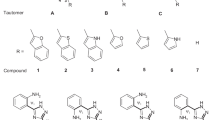Abstract
In this work, chemical computations were carried out to study of tautomeric conversion of 5-fluorouracil (A → products) at CBS-QB3, M06-2x, and B3LYP levels of theory. These 11 tautomers connected to each other via 10 transition state molecules and four pathways. In addition, the stationary points (including stable structures and transition states), in which playing a significant role on ground potential energy surfaces of isomerization processes, were found. Multichannel RRKM steady-state approximation calculations have been performed to calculate the rate constants at 1 atm pressure and over a range of temperature from 268.15 to 310.15 K to cover the in vivo and atmospheric conditions. The stability ranking of tautomers obtained and demonstrated that di-keto form of 5-fluorouracil is the most stable tautomer. The energy barriers for tautomeric conversions were calculated. The information reported in this study may help with the identification of drug in vivo and in the laboratory.






Similar content being viewed by others
References
Löwdin P-O (1963) Proton tunneling in DNA and its biological implications. Rev Mod Phys 35(3):724
Fallon L (1973) The crystal and molecular structure of 5-fluorouracil. Acta Crystallogr Sect B Struct Crystallogr Cryst Chem 29(11):2549–2556
Goodman LS (1996) Goodman and Gilman’s the pharmacological basis of therapeutics, vol 1549. McGraw-Hill, New York
Dorman DC, Coddington KA, Richardson RC (1990) 5-Fluorouracil toxicosis in the dog. J Vet Intern Med 4(5):254–257
Kim HO et al (1992) Asymmetric synthesis of 1,3-dioxolane-pyrimidine nucleosides and their anti-HIV activity. J Med Chem 35(11):1987–1995
Verheggen I et al (1995) Synthesis, biological evaluation, and structure analysis of a series of new 1,5-anhydrohexitol nucleosides. J Med Chem 38(5):826–835
Wojnarowska Z et al (2010) On the kinetics of tautomerism in drugs: new application of broadband dielectric spectroscopy. J Chem Phys 133(9):094507
Lukmanov T et al (2013) Relative stability of keto-enol tautomers in 5,6-substituted uracils: ab initio, DFT and PCM study. Comput Theor Chem 1023:38–45
Monajjemi M, Honarparvar B, Monajemi H (2006) Investigation of NQR parameters on the tetrazole-azide tautomeric equilibria: a DFT study. J Mex Chem Soc 50(4):143–148
Jena NR, Mark AE, Mishra PC (2014) Does tautomerization of FapyG influence its mutagenicity? ChemPhysChem 15(9):1779–1784
Mirzaei M (2017) 5-Fluorouracil: computational studies of tautomers and NMR properties. Turk Comput Theor Chem 1(1):27–34
Bednarek E et al (2000) Theoretical and experimental 1H, 13C, 15N, and 17O NMR chemical shifts for 5-halogenouracils. J Mol Struct 554(2–3):233–243
Scanlan MJ, Hillier IH (1984) An ab initio study of tautomerism of uracil, thymine, 5-fluorouracil, and cytosine. J Am Chem Soc 106(13):3737–3745
Les A, Adamowicz L (1989) Oxo-hydroxy tautomerism of uracil and 5-fluorouracil. J Phys Chem 93(20):7078–7081
Lozeron HA et al (1964) The photochemistry of 5-fluorouracil. Biochemistry 3(12):1844–1850
Voet DH, Rich A (1969) Structure of an intermolecular complex between cytosine and 5-fluorouracil. J Am Chem Soc 91(11):3069–3075
Pavel I et al (2005) Raman, surface enhanced Raman spectroscopy, and DFT calculations: a powerful approach for the identification and characterization of 5-fluorouracil anticarcinogenic drug species. J Phys Chem A 109(44):9945–9952
Wetmore SD, Boyd RJ, Eriksson LA (2001) A theoretical study of 5-halouracils: electron affinities, ionization potentials and dissociation of the related anions. Chem Phys Lett 343(1–2):151–158
Hofacker G (1981) Henry Eyring, SH Lin, SM Lin: Basic chemical kinetics. John Wiley & Sons, New York, Chichester, Brisbane, Toronto 1980. 493 Seiten, Preis:£ 20. Berichte der Bunsengesellschaft für physikalische Chemie 85(7):618–619
Pan S, Wang L (2014) Atmospheric oxidation mechanism of m-xylene initiated by OH radical. J Phys Chem A 118(45):10778–10787
Wood GP et al (2006) A restricted-open-shell complete-basis-set model chemistry. J Chem Phys 125(9):094106
Safaei Z et al (2018) Reaction mechanisms and kinetics of the β-elimination processes of compounds CHF2CH2SiFnMe3-n (n = 0–3): DFT and CBS-QB3 methods using Rice–Ramsperger–Kassel–Marcus and transition state theories. J Fluor Chem 216:71–80
Sirjean B et al (2007) Extension of the composite CBS-QB3 method to singlet diradical calculations. Chem Phys Lett 435(1–3):152–156
Bartlett RJ et al (1990) Non-iterative fifth-order triple and quadruple excitation energy corrections in correlated methods. Chem Phys Lett 165(6):513–522
Stanton JF (1997) Why CCSD (T) works: a different perspective. Chem Phys Lett 281(1–3):130–134
Sousa J et al (2013) Application of computational chemistry methods to obtain thermodynamic data for hydrogen production from liquefied petroleum gas. Braz J Chem Eng 30(1):83–93
Ochterski JW, Petersson GA, Montgomery JA Jr (1996) A complete basis set model chemistry. V. Extensions to six or more heavy atoms. J Chem Phys 104(7):2598–2619
Moss G (1996) Basic terminology of stereochemistry (IUPAC Recommendations 1996). Pure Appl Chem 68(12):2193–2222
Ha T-K et al (1999) Energy increment method based on quantum chemical results: a general recipe for approximative prediction of isomerization and tautomerization energies of pyrimidine and purine nucleic acid bases and related compounds. J Phys Chem A 103(33):6612–6623
Mousavipour SH, Pirhadi F, HabibAgahi A (2009) A theoretical investigation on the kinetics and mechanism of the reaction of amidogen with hydroxyl radical. J Phys Chem A 113(46):12961–12971
Shavitt I (1959) A calculation of the rates of the ortho-para conversions and isotope exchanges in hydrogen. J Chem Phys 31(5):1359–1367
Author information
Authors and Affiliations
Corresponding author
Additional information
Publisher's Note
Springer Nature remains neutral with regard to jurisdictional claims in published maps and institutional affiliations.
Electronic supplementary material
Below is the link to the electronic supplementary material.
Rights and permissions
About this article
Cite this article
Padash, R. Mechanism and kinetic investigations of 5-fluorouracil tautomeric conversions in the gas phase: DFT and CBS-QB3 methods using multichannel Rice–Ramsperger–Kassel–Marcus steady-state approximation theory. Theor Chem Acc 139, 59 (2020). https://doi.org/10.1007/s00214-020-2574-3
Received:
Accepted:
Published:
DOI: https://doi.org/10.1007/s00214-020-2574-3




